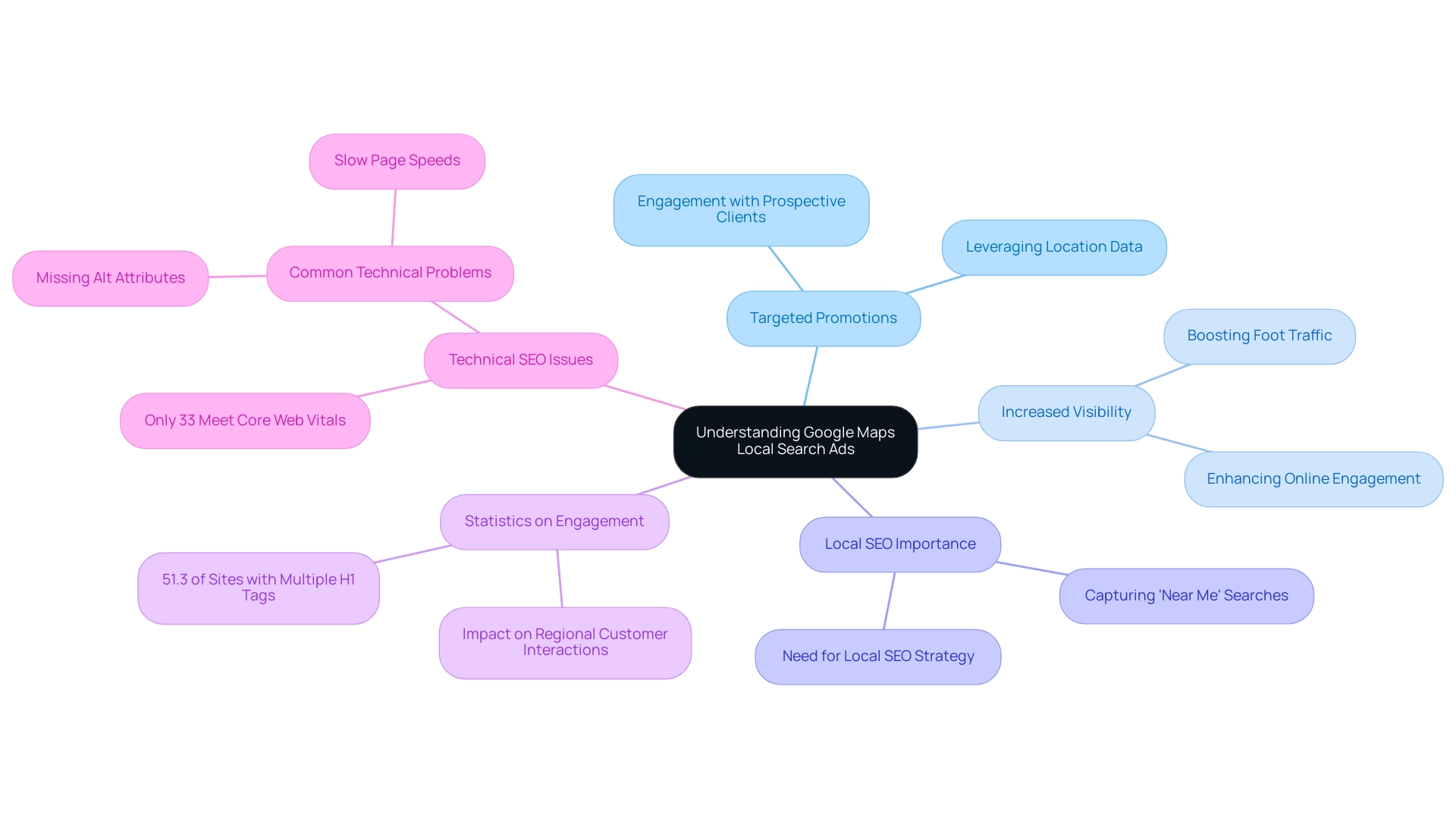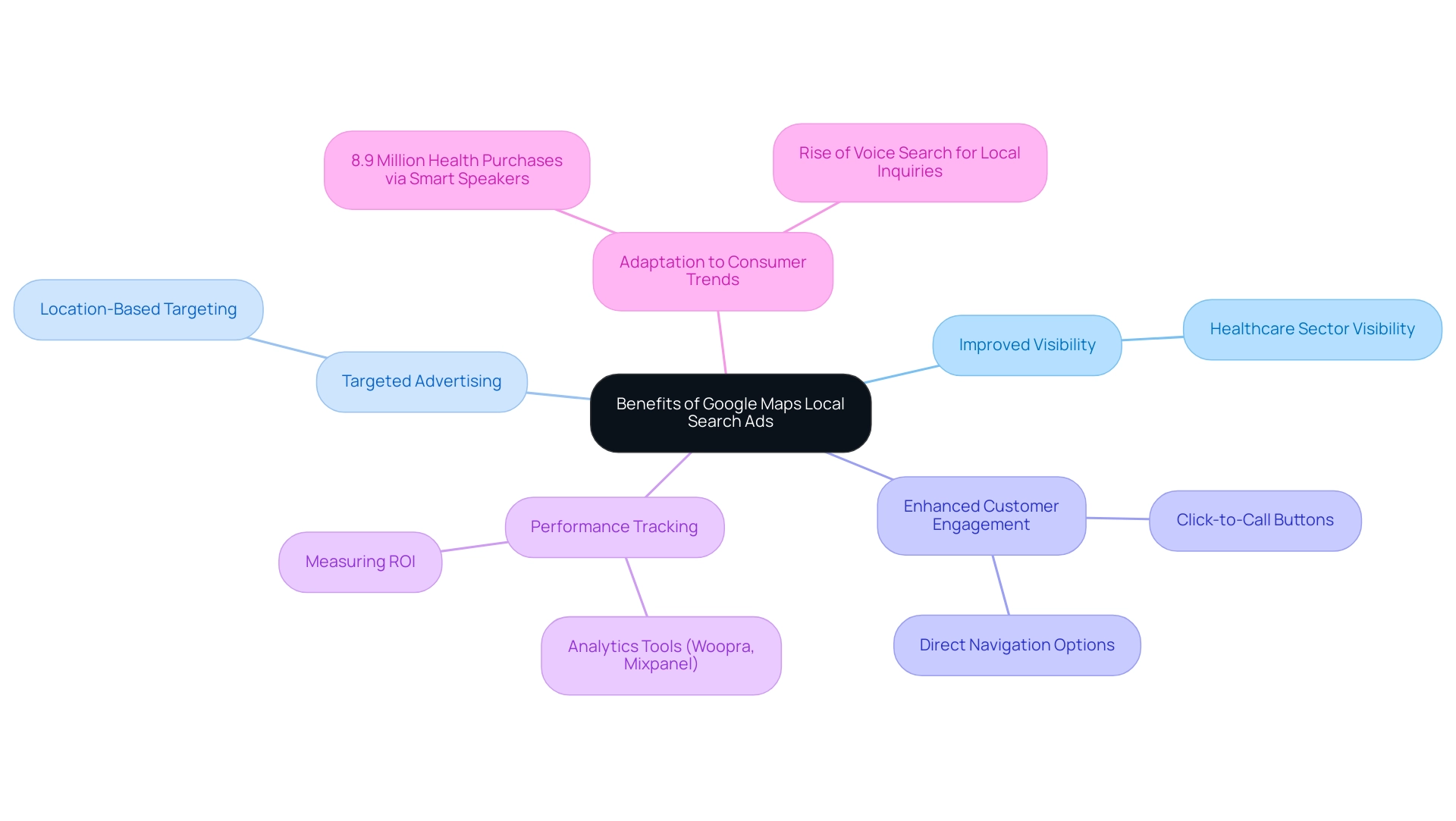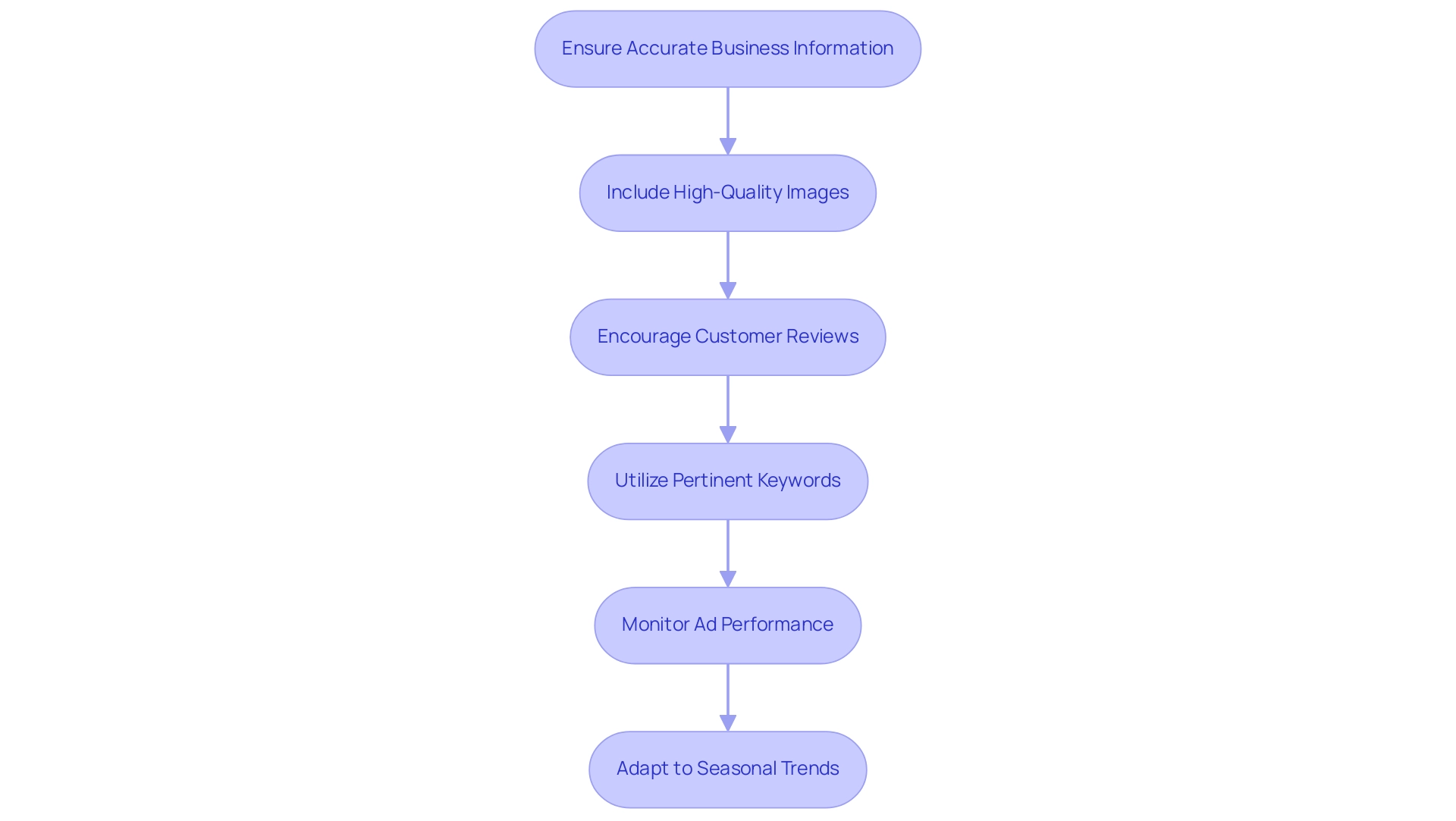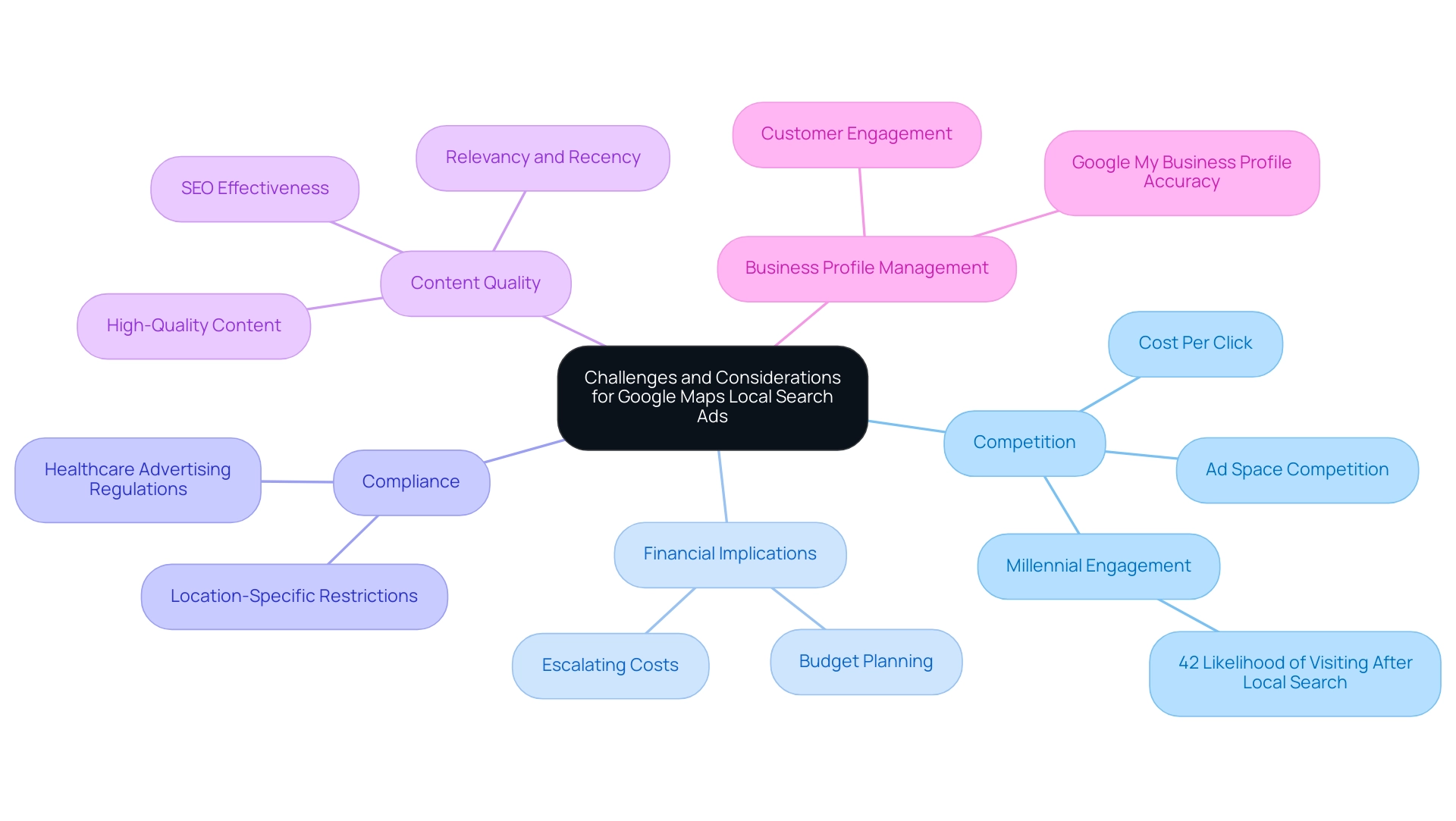Introduction
In the competitive landscape of local business advertising, Google Maps Local Search Ads emerge as a powerful tool for enhancing visibility and driving customer engagement. These targeted advertisements not only allow businesses to connect with potential customers actively seeking their services but also leverage location data to ensure relevance.
As consumer behavior increasingly shifts towards localized searches, particularly in sectors like healthcare, understanding the strategic benefits and best practices for implementing these ads becomes essential. However, navigating the challenges associated with competition, compliance, and optimization requires a thoughtful approach to maximize their effectiveness.
This article delves into the intricacies of Google Maps Local Search Ads, exploring their advantages, implementation strategies, and potential hurdles that businesses must address to thrive in a digitally-driven marketplace.
Understanding Google Maps Local Search Ads
Google Maps Local Search Ads serve as targeted paid promotions that appear prominently when users conduct searches for specific services or establishments in their geographical area. These advertisements are designed to increase the visibility of nearby enterprises, offering them the chance to engage with prospective clients who are actively searching for their services. By leveraging location data and relevant keywords, these advertisements significantly enhance the chances of being discovered by nearby users.
According to Ahrefs, 51.3% of sites have multiple H1 tags, highlighting the importance of a well-structured SEO strategy to enhance search visibility. Moreover, recent statistics show that enterprises utilizing Google Maps Local Search Ads experience a significant rise in foot traffic and online engagement, with case studies illustrating their impact on boosting regional customer interactions. The strategic integration of Google Maps Local Search Ads within Maps not only drives foot traffic but also encourages online interaction by providing direct access to a company’s website or contact information.
This dual capability underscores the importance of adopting a robust local SEO strategy, particularly as local businesses strive to capture the growing number of ‘near me’ searches that dominate consumer behavior today. Furthermore, resolving technical SEO problems is essential; as highlighted in the Technical SEO Statistics case study, only 33% of websites meet the Core Web Vitals threshold, suggesting a considerable area for enhancement to optimize the efficiency of Maps advertisements.

Benefits of Using Google Maps Local Search Ads
The advantages of utilizing Google Maps local search ads are extensive. Mainly, Google Maps local search ads greatly improve visibility in nearby results, ensuring that companies appear prominently when potential clients look for services in their area. This heightened visibility is especially vital in the healthcare sector, where patients frequently perform local inquiries for providers.
Additionally, Google Maps local search ads support targeted advertising, allowing companies to connect with users based on their exact location and intent. This focus on relevance can drive higher conversion rates through Google Maps local search ads, translating into more inquiries and appointments for healthcare organizations. The incorporation of interactive features, such as click-to-call buttons and direct navigation options, streamlines customer engagement, allowing prospective patients to connect with providers swiftly.
In addition, the ability to track and analyze ad performance using tools like Woopra and Mixpanel empowers businesses to measure their return on investment (ROI) effectively. This data-driven approach enables organizations to refine their marketing strategies continuously, enhancing overall effectiveness. As indicated by Ahrefs, 51.3% of sites possess multiple H1 tags, which highlights the significance of optimizing search ads for improved visibility.
Moreover, the increasing trend of consumers utilizing smart speakers for nearby inquiries is significant, with 8.9 million purchasing health and beauty items via these devices between August 2019 and 2021. This suggests a shift towards localized digital engagement, emphasizing the necessity for companies to adapt their advertising strategies accordingly. Additionally, a case study on voice search statistics reveals that a notable percentage of consumers regularly use voice search for local inquiries, further supporting the argument for the effectiveness of Maps Local Search Ads.

Best Practices for Implementing Google Maps Local Search Ads
To effectively execute Google Maps local search ads, enterprises must focus on enhancing their My Business profile. This process begins with ensuring that essential information such as the business name, address, phone number, and operating hours is accurate and up to date. Additionally, the inclusion of high-quality images and the proactive encouragement of customer reviews significantly enhance the profile’s appeal.
With over 25 million downloads, Maps is a highly relevant platform, underscoring the importance of optimization. Utilizing pertinent keywords within advertisement text is also essential to enhancing relevance, particularly for Google Maps local search ads, considering that the leading platform holds about 92% of the US engine market share. Regular monitoring of ad performance and making adjustments based on data insights is essential for optimizing campaigns effectively.
Furthermore, considering seasonal trends and local events allows companies to tailor their advertising efforts to better align with the needs of their target audience, thus maximizing engagement and effectiveness. As clinic owners evaluate their advertising budgets, it’s important to recognize that the cost of SEO solutions can vary widely, ranging from a few hundred dollars per month for basic services to several thousand for comprehensive campaigns. This investment is crucial, especially considering the case study demonstrating that optimizing for the leading search engine, which holds the vast majority of the market, is vital for enhancing online visibility.

Challenges and Considerations
While google maps local search ads offer significant advantages for companies, they also pose various challenges that require careful consideration. One pressing issue is the intense competition for ad space, particularly in urban areas where numerous enterprises compete for visibility. In fact, competition statistics suggest that 42% of millennials are likely to visit an establishment after performing a nearby inquiry, especially on mobile devices, highlighting the importance of effective regional advertising strategies.
Notably, 80% of mobile searches with local intent lead to conversions, highlighting the critical role that google maps local search ads play in driving success. This competition can escalate costs per click, which averages around [insert average cost per click here], making it essential for organizations to establish a well-planned budget to navigate these financial implications. Furthermore, compliance with healthcare advertising regulations is critical, as these rules can differ by location and may impose restrictions on specific types of promotions.
This adds another layer of complexity for clinic owners. Additionally, maintaining an updated and accurate Google My Business profile is paramount; any discrepancies can lead to customer frustration and missed opportunities. As highlighted by industry experts,
providing fair, balanced, and comprehensive content
is vital in this competitive landscape.
The case study titled ‘Content Quality, Relevancy, and Recency‘ emphasizes the importance of continuously updating and publishing high-quality content for effective SEO. By proactively addressing these challenges, businesses can significantly enhance the effectiveness of their google maps local search ads campaigns.

Conclusion
Google Maps Local Search Ads offer a compelling avenue for local businesses to elevate their visibility and connect with potential customers directly in their area. By leveraging location data and relevant keywords, these ads not only enhance discoverability but also drive foot traffic and online engagement. The strategic use of interactive features, such as click-to-call buttons, further streamlines customer interactions, making it easier for users to reach out to businesses.
The benefits of implementing Google Maps Local Search Ads are clear, especially in sectors like healthcare, where localized searches are paramount. Targeted advertising based on user intent can lead to higher conversion rates, ultimately translating into increased inquiries and appointments. However, the success of these ads hinges on well-optimized Google My Business profiles and a data-driven approach to performance tracking. Regular monitoring and adjustments based on analytics are crucial to refining advertising strategies and maximizing return on investment.
Despite the advantages, businesses must remain vigilant about the challenges associated with competition and compliance. The crowded ad space in urban areas can drive up costs, necessitating a well-planned budget. Moreover, adherence to local advertising regulations is essential, particularly in the healthcare industry. By addressing these challenges proactively and continuously improving content quality, businesses can position themselves effectively in the competitive landscape of local search advertising. Embracing Google Maps Local Search Ads is not merely an option; it is a strategic imperative for businesses aiming to thrive in a digitally driven marketplace.

